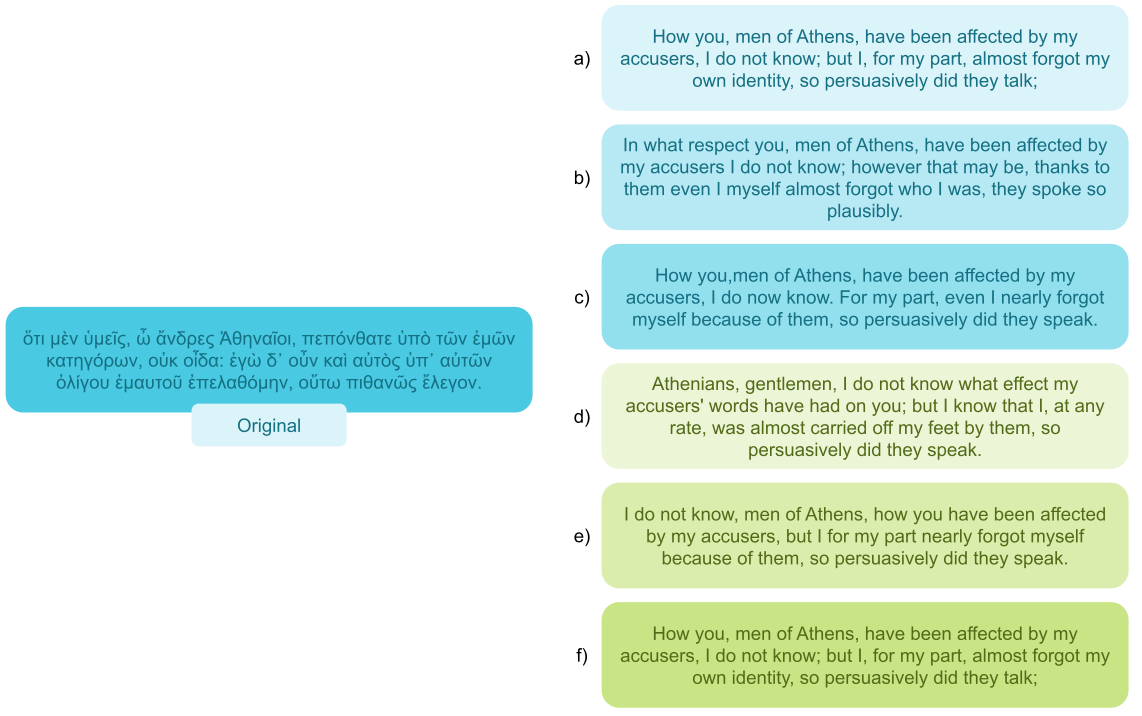Building a Comparative Translation Database for Classical Texts with LLMs
Project overview
.png)
Translations play a significant part in our understanding of the Ancient World. In the 1970s, Norton (1968) noted a growing availability of translations of Latin and Greek classics. However, Homer’s Iliad, e.g., has been translated so often that Margon stated “that there can never be a definitive translation of any ancient work” (1970, p. 298). The questions of what happens to the original during and after the translation process, what the purpose of the translation is and how it represents (if at all) the intended meaning of the original were of particular interest to the classicists (George 1975) and also addressed by Jacques Derrida (1985).
In the digital age, the works of ancient authors are just one click away (see, e.g., Perseus and the Loeb Classics Library)—and with them, their (many) translations. This abundance of translations offers the possibility of building a diachronic corpus of translations for further analysis and comparisons. It is currently impossible to compare translations with the originals to answer questions like Are English translations different from German translations? or Are the differences grammatical, stylistic, or content-related?
Our case study will shed light on multilingual translation practices spanning several decades, exploiting large language models (LLMs) for analytical and interpretative tasks. We select a sample of Greek and Latin original texts on a spectrum from easy-to-read authors to more complex ones and build a translation database that allows users to view translation variants side-by-side (see Figure 1). We employ large LLMs like GPT (OpenAI 2023) to (i) highlight the differences (style, word choice, grammar, idiomaticity), (ii) provide preferences depending on the intended use of the translation (e.g., a layperson might be satisfied with a more accessible translation), and (iii) generate automatic translations. The findings will also improve the automatic translation of hitherto untranslated works.
References
Further relevant literature that is yet to be mentioned in the abstract could include Gillespie (2011), Bandina, Hadley, and McElduff (2024), and Lianeri and Zajko (2009).
- Bandina, Paul F., James Hadley, and Siobhán McElduff, eds. 2024. Translation and the Classic. Oxon, New York: Routledge. https://www.routledge.com/Translation-and-the-Classic/Bandia-Hadley-McElduff/p/book/9781032670720.
- Derrida, Jacques. 1985. ‘Des Tours de Babel’. In Difference in Translation, edited by Joseph F. Graham, 165–208. Ithaca and London: Cornell University Press.
- Emlyn-Jones, C. J., William Preddy, and Peter Eötvös. 2017. Euthyphro. Loeb Classical Library. Cambridge and London: Harvard University Press.
- Fowler, Harold North, W. R. M. Lamb, Robert Gregg Bury, and Paul Shorey, eds. 1914. Plato in Twelve Volumes : with an English translation. Vol. 1. Cambridge and London: Harvard University Press and W. Heinemann Ltd. http://archive.org/details/b2900049x_0009.
- George, Edward V. 1975. ‘Periodical Literature on Teaching the Classics in Translation, 1924-1975: An Annotated Bibliography’. In The Classical World 69 (3): 161–99. https://doi.org/10.2307/4348397.
- Gillespie, Stuart. 2011. English Translation and Classical Reception: Towards a New Literary History. John Wiley & Sons, Ltd. https://onlinelibrary.wiley.com/doi/book/10.1002/9781444396508.
- Lianeri, Edited by Alexandra, and Vanda Zajko, eds. 2009. Translation and the Classic: Identity as Change in the History of Culture. Classical Presences. Oxford, New York: Oxford University Press.
- Margon, Joseph S. 1970. ‘Through the Glass Clearly: Teaching Classical Literature in Translation’. In The Classical World 63 (9): 297–301. https://doi.org/10.2307/4347213.
- Norton, Mary E. 1968. ‘Classics in Translation’. In The Classical World 61 (8): 331–33. https://doi.org/10.2307/4346524.
- OpenAI. 2023. ‘GPT-4 Technical Report’. arXiv. http://arxiv.org/abs/2303.08774.
- West, Thomas G., and Grace Starry West. 1984. Four Texts on Socrates : Plato’s Euthyphro, Apology, and Crito, and Aristophanes’ Clouds. Ithaca: Cornell University Press. http://archive.org/details/fourtextsonsocra0000unse_t0m0.